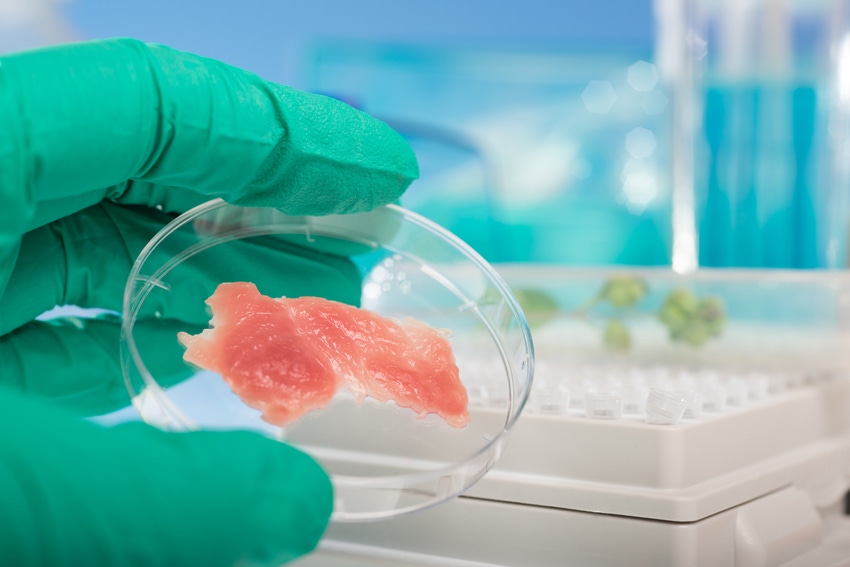Journey to grocery store challenged by labeling, cost, commercial production, oversight and safety.

Clean meat, lab meat, fake meat: Many terms are used to describe the food products created from cultivated cells of animal origin. The technology to culture animal cells and produce food for human consumption is progressing quickly and could even find its way onto grocery shelves within the next five years, but there are also serious questions, concerns and challenges to be addressed first.
The Council for Agricultural Science & Technology (CAST) created a task force of experts to discuss obstacles that must be resolved before cell-cultured meat can be purchased at local grocery stores. A new report shed light on the topic, the technology and a variety of other challenges the process faces in trying to reach commercialization.
“At this point, there are probably more questions than clear answers about these emerging products, but we thought it was an important time to think about the challenges and questions that need to be answered,” said Dr. Anna Dilger, an associate professor in the animal science department at the University of Illinois at Urbana-Champaign. “For example, how will products be labeled? Who will perform the needed oversight to ensure that these products are safe? What are the anticipated food safety risks with these products? It is our hope that by bringing these questions to light, constructive discussions to address these and other potential issues can occur.”
Dilger served as CAST liaison to the task force that authored the paper.
Certainly, the cell culture technology itself needs to be further developed and the safety of the products thoroughly evaluated, but consumer acceptance will matter as well, the experts reported.
For example, comparisons with conventional meat will need to be scientifically investigated, and the appearance, smell, taste, texture and nutritional profile of the products should very closely mimic traditional meat. If the cell-cultured food products do not align with the characteristics of conventional meat, consumers may be less accepting of the alternative, they suggested.
“Like with any new product, consumers will ultimately determine its success or failure. What the industry can do is provide transparency about the process, clear labeling of these products and ensure that they are safe for people to eat. Consumers will decide how and when they want to incorporate them into their diet,” Dilger said.
Several technology hurdles have also proved challenging for scaling up cell cultivation, the report noted, including lowering the cost of media, developing cell lines that can be propagated indefinitely and possess specific palatable and nutritional characteristics, establishing scalable bioprocesses, reducing the operational costs of large-scale biomanufacturing facilities and figuring out disposal, recycling or amelioration of waste products. Two major challenges with tissue manufacturing are the complexity of recreating tissue structure with bioprinters and the associated costs of using tissue structuring and cultivation equipment.
Then, there’s the regulation and oversight debate, according to the report: “The development of cell-cultivated meat as a potential human food has resulted in considerable debate about how such materials would be regulated in the United States.”
The report explained that under federal regulations, the U.S. Food & Drug Administration and the U.S. Department of Agriculture's Food Safety & Inspection Service (FSIS) have different responsibilities with respect to meat and meat products. FSIS oversees meat, poultry and certain egg products pursuant to the Federal Meat Inspection Act, the Poultry Products Inspection Act and the Egg Products Inspection Act. FDA exercises jurisdiction over all other food products pursuant to the Federal Food, Drug & Cosmetic Act, which importantly, authorizes FDA to oversee the safety of all ingredients used in both FDA- and USDA-regulated foods.
“With production methods for cell-cultivated meats clearly spanning areas where both FDA and USDA-FSIS have regulatory authority, both agencies have determined that there needs to be formal cooperation between the two,” the authors noted.
During a webinar hosted by CAST, report co-author Jess Krieger, a Ph.D. candidate who works in the Innate Immunity & Tissue Engineering Laboratory at Kent State University, noted that the cultivated meat industry is trying to create a method of meat production that has less of an impact on the environment and climate change than other aspects of meat production.
“The advantage for the cultivated meat industry is really going to be that it can create a system sustainable for the environment,” she said. “There is a lot of work that has to be done, but that’s a target goal for our entire industry.”
About the Author(s)
You May Also Like




.png?width=300&auto=webp&quality=80&disable=upscale)
